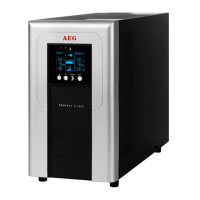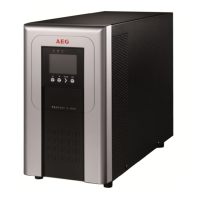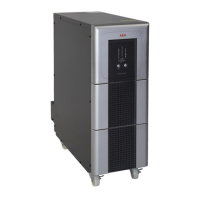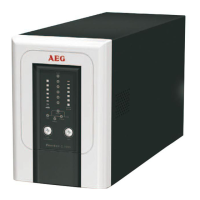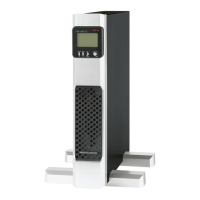
Do you have a question about the AEG PROTECT C. 6000 and is the answer not in the manual?
Explains the purpose and content of the operating instructions for safe and proper use.
States that instructions comply with current technical specifications at the time of delivery.
Outlines the terms of warranty and liability, including rights to alter specifications.
Describes design for operation and maintenance by trained and qualified personnel.
Provides contact information for questions and support regarding the UPS.
States copyright and usage restrictions for the operating instructions manual.
Describes the PROTECT C. UPS, its function, and key components.
Explains how the UPS connects to mains and loads, and its power conversion process.
Lists detailed technical specifications for input, output, overload, and battery.
Lists compliance with product norms and CE directives for safety and compatibility.
Emphasizes compliance with regulations for personnel and unit safety during operation.
Specifies that only trained and authorized personnel should operate or maintain the UPS.
Provides critical safety warnings regarding high voltage, battery hazards, and proper earthing.
Declaration of Conformity with relevant standards and directives for product safety.
Instructions on checking for transport damage and completeness of the UPS delivery.
Recommendations for positioning the UPS during transportation and installation.
Notes on selecting a suitable installation location and environmental conditions.
Illustrates and explains the front view, display, and rear connections of the UPS.
Explains the functions of the pushbuttons and LED indicators on the UPS front panel.
Diagrams and comments detailing connections on the rear of the UPS units.
Safety precautions and checks required before starting any connection tasks on the UPS.
Safety checks required before setting up the UPS and external battery modules.
Guidance on general mains connection, including connector checklists.
Table detailing required cable diameters and fuse ratings for mains and load connections.
Preparation and connection steps for the single-phase mains power cable.
Step-by-step guide for connecting the mains power cable to the UPS input.
Checks required before connecting loads to the UPS, ensuring power compatibility.
Instructions for connecting loads to the UPS output terminals.
Information on connecting compatible external battery packs for extended backup time.
Instructions for mechanically securing the UPS unit after connections are made.
Details the possible operating modes of the UPS system.
Explains the standard online mode where the UPS supplies power continuously.
Describes UPS operation when mains power fails, using battery backup.
Explains the bypass mode used for overload or overtemperature conditions.
Details the use of the manual bypass for maintenance and service operations.
Warnings and procedures for managing UPS overload conditions to prevent damage.
Information on connecting the UPS to a computer via the RS232 serial interface.
Details on optional communication cards that can be installed for expanded connectivity.
Information about the 'CompuWatch' software for UPS management and shutdown.
Explains the meaning of different LED indicators and status signals on the UPS.
A comprehensive table correlating LED displays with operation status and alarm signals.
Guidance on diagnosing and rectifying common UPS faults and error messages.
Lists common UPS problems, their potential causes, and recommended solutions.
Explains the n+x technology for parallel UPS configurations to increase power or availability.
Steps for connecting multiple UPS units in parallel, including wiring and configuration.
Procedures for activating and managing UPS units operating in a parallel compound.
Instructions for activating a parallel UPS system after hardware setup.
Procedures for adding or removing UPS units from an existing parallel configuration.
Explains automatic battery charging and provides typical charging times based on expansions.
Details the recommended maintenance tasks, intervals, and where to find descriptions.
Guide for performing visual inspections of the UPS unit for damage or foreign bodies.
How to detect battery ageing through regular capacity and standby time checks.
Instructions for checking the UPS fans for dust build-up and unusual noise development.
Guidelines for proper long-term storage of the UPS and battery to prevent damage.
Steps for dismantling the UPS system in reverse order of installation.
Regulations for environmentally sound disposal of UPS components in compliance with legal guidelines.
Definitions of technical terms used throughout the operating instructions manual.

